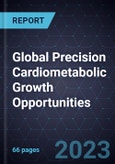Integrated Care Business Models and Partnerships Drive Precision Health Initiatives
Cardiometabolic diseases, including cardiovascular disease (which encompasses coronary artery diseases, chronic/congestive heart failure, stroke, and hypertension), type 2 diabetes, and obesity, have been increasing globally. As a result, the healthcare cost burden has become significant and is anticipated to rise further.
Existing drug therapies for these conditions are focused on a one-size-fits-all approach, and there is a lack of patient-centricity and variability in disease management. In addition, improving the affordability and accessibility of therapies in countries with high prevalence is necessary.
Patient-centric treatment requires a combination of nutritional, behavioral, and drug therapies for cardiometabolic disease, with drugs serving as a supplementary measure to behavioral therapies. The shift to precision health has increased focus on conducting research based on unique genetic variations (genome-wide association studies) that will enable the identification of gene-drug interactions for novel drug discovery.
Life science (LS) companies are anticipated to augment their omics-based research efforts to develop safe and efficacious pharmacological and digital therapies to treat and manage cardiometabolic diseases. Strategic research partnerships with genomic data providers are poised to accelerate the development of novel classes of regenerative medicines, nutrigenomics, pharmacogenomics, metabolomics, and beyond-the-pill solutions.
Furthermore, the high prevalence of cardiometabolic diseases has led the healthcare industry to adopt an integrated care model. This approach involves implementing additional therapies, such as digital therapeutics, AI-based predictive diagnostic tools, and nutritional and behavioral therapies, in conjunction with traditional drug treatment.
This model has enabled the establishment of a comprehensive care continuum across the industry, with wellness programs playing a crucial role in disease diagnosis, treatment, and monitoring. The convergence of biopharma, DTx, medical devices, and health technology will play a significant role in the shift to integrated patient management and holistically support the entire patient journey for cardiometabolic disease management, which has proven to be an effective strategy in improving patient outcomes while lowering the cost of care.
As cardiometabolic disease case numbers continue to rise worldwide, it is essential to prioritize the implementation of comprehensive care models that leverage the benefits of adjunct therapies. The purpose of this study is to identify the primary growth opportunities that will drive the market in the near future.
The study also aims to highlight the most prominent and emerging business models prevalent across the market, which will enable industry stakeholders to enhance their geographic coverage in terms of patient outreach and address the challenges of limited patient access. The study also sheds light on some crucial market drivers and restraints that impact growth.
It provides brief yet significant insights into the game-changing participants (across each indication) striving to develop disruptive drugs and technologies to maintain their growth trajectories. The study also focuses on the leading M&A and partnership activities impacting the market as well as present and future market trends that will shape the market's future.
Research Highlights
- Overview of the global precision cardiometabolic market
- Trends
- Dynamics of the care continuum, including diagnostics/screening, targeted therapeutics, surveillance and monitoring, and after-care patient support
- Prevalent and emerging business models across the market
- Key market drivers and restraints, partnerships, M&A
- Industry use cases based on disease area
- Emerging growth opportunities








